Cliques and Clique Covers in Interval-Valued Fuzzy Graphs
- DOI
- 10.2991/ijcis.d.210610.001How to use a DOI?
- Keywords
- Interval-valued fuzzy graph; fuzzy cliques; clique covers
- Abstract
Finding cliques and clique covers in graphs are one of the most needful tasks. In this paper, interval-valued fuzzy cliques (IVFQs) and interval-valued fuzzy clique covers (IVFQCs) of an interval-valued fuzzy graph (IVFG) are introduced by introducing the fuzziness because, the crisp graphs has some limitations in real world due to uncertainty of vagueness. Here, the concept of cliques and clique covers are slightly modified so that every IVFQ is complete. Also, a clique cover of a crisp graph always covers all the edges and vertices of the graph whereas, the IVFQCs obtained by fuzzify to the clique covers does not satisfy the property. Hence, the definition is modified and studied some theorems on it. To better understand the useability of this work a model application is stated in this paper.
- Copyright
- © 2021 The Authors. Published by Atlantis Press B.V.
- Open Access
- This is an open access article distributed under the CC BY-NC 4.0 license (http://creativecommons.org/licenses/by-nc/4.0/).
1. INTRODUCTION
In our real life situations, we see that some objects are related by some relations. For example, in a city, places are connected by trum ways. There may have a problem to construct the transportation roads so that there is minimum number of ways to move from one place to another place. These type of problems can easily be handled by considering the objects as nodes (or, vertices) and trum ways are the links (or, edges). This one-to-one representation is called the graph. The concept of graph theory was first introduced by Euler in his paper “Seven bridges of Königsberg” (1736). A suitable mathematical model is needed when fuzziness arises in the kind of objects or that in the relationship among the objects. Rosenfeld [1] first developed the crisp graph to fuzzy graph by introducing fuzzy relation in fuzzy sets which was first introduced by Zadeh [2]. Since then, researchers are delve into field of fuzzy graph theory and many of the real phenomena has been expressed in terms of fuzzy model (see [3]). Thus the field of fuzzy graph theory is flourishing it can handle the vaguenesses in real-world. Several real-world problems like human cardiac function, fuzzy neural network, routing problem, traffic light problem, time table scheduling, etc. can be nicely expressed using fuzzy graph model.
After Rosenfeld, fuzzy graph theory developed with many variations in fuzziness. In 1971, Zadeh [4] introduced the concept of interval-valued fuzzy sets (IVFSs) to generalize the fuzzy sets [2] in which the membership function describes to return interval numbers instead of classical numbers. It is more strong enough to consider the uncertainty cases than the traditional fuzzy sets as interval numbers are considered instead of classical numbers. The interval-valued fuzzy graph (IVFG) theory studies the generalized class of fuzzy graphs with IVFSs with interval-valued fuzzy relations. Therefore, it has more area of applications such as fuzzy control, approximate reasoning, medical diagnosis, intelligent control, multivated logic, etc. Talebi and Rashmanlou [5] studied isomorphism on IVFG. Several theorems and the properties of Complete IVFGs are studied by Rashmanlou and Jun in their literature [6]. Pal and Rashmanlou [7] have studied another variation of IVFG namely, irregular IVFG in which the adjacent vertices have distinct degrees. Antipodal IVFG is an another classification of IVFG which is introduced by Rashmanlou and Pal [8]. They also have defined a new type of IVFG – Balanced IVFG in the literature [9]. Bipolar fuzzy graphs are studied by Rashmanlou et al. [10]. Pramanik et al. [11] have extended the fuzzy competition graph to a bipolar fuzzy competition graph so that it can solve several real-world problems. Samanta et al. [12] have represented and analyzed the competitions among the participants in social networks. Pramanik et al. [13] have introduced the fuzzy
In today's communication networks, one person has friends (or buddies) and it is assumed that each friend in his friend list is known to each other. This type of network in graph modelling is called the clique (See Figure 1). The maximal clique is a clique with no proper subset which is also a clique. The maximal clique with maximum number of nodes (vertices) is the maximum clique. In many problems such as circuit design, transprotation, human brain analysis, artificial intelligence etc., it is an important task to find the set of maximum number of nodes (vertices) each of which are related to each other. Motivating from this idea, IVFQs and IVFQCs of IVFGs are studied in this article. It is also known that, if all the vertices of any subgraph of a graph forms a clique, then the subgraph is complete. But this conceptual phenomena is not intact in fuzzy graph according to the definition of fuzzy cliques introduced by Nair and Cheng [30]. In this paper, we have modified the definition of IVFQ and IVFQC given by Nair and Cheng and found a new dimension of work. We have built a connection between crisp concept and interval-valued fuzzy concept. The definition of fuzzy clique is modified so that every complete fuzzy subgraph is a fuzzy clique and then the fuzzy cliques and fuzzy clique covers are generalized for IVFGs.
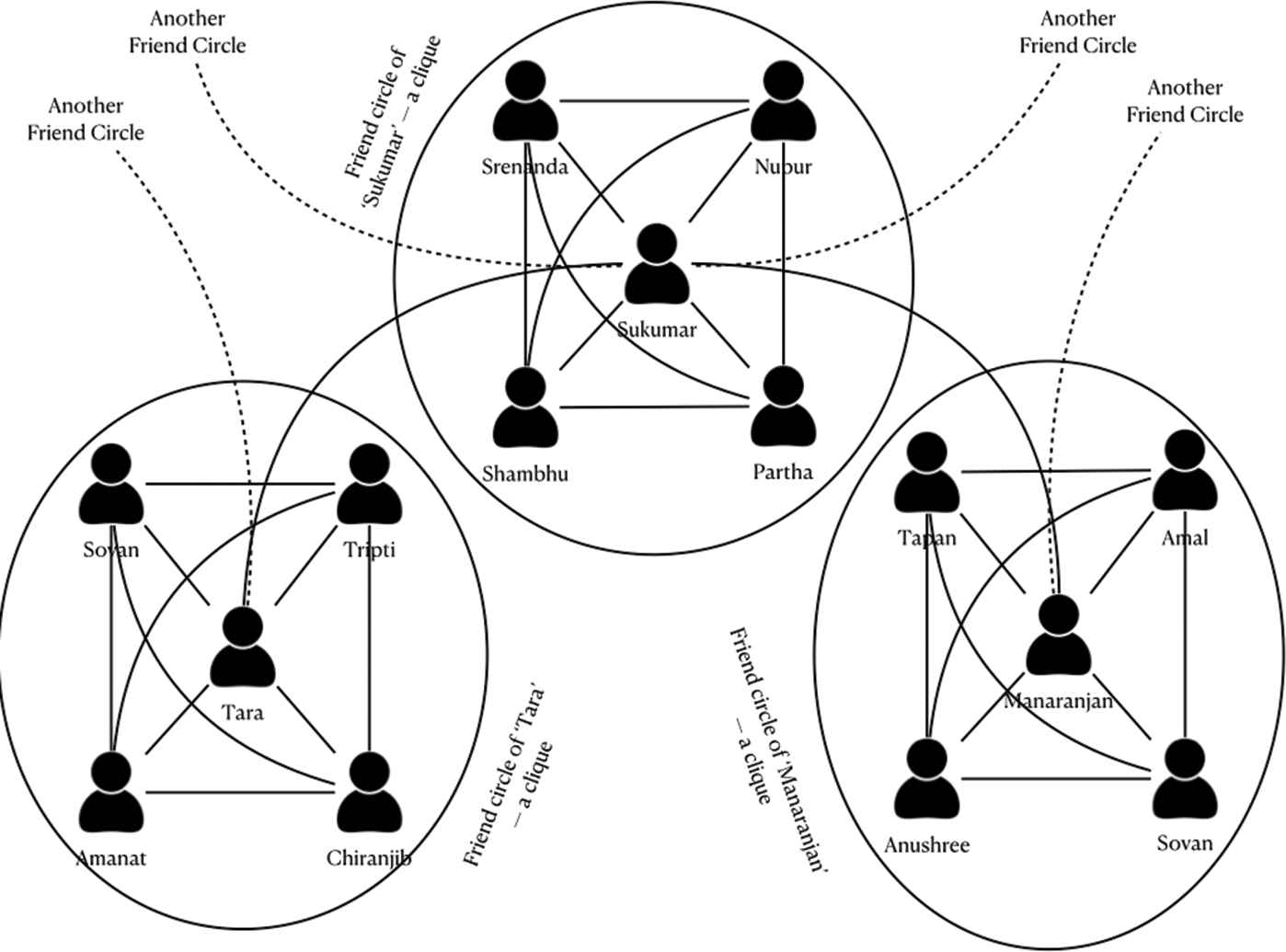
An example of communication network consisting of cliques.
Definition of the problem
In this paper, IVFQs and IVFQCs of an IVFG are introduced here. The concept of cliques and clique covers are modified to show that every IVFQ is complete. Also, a clique cover of a crisp graph always covers all the edges and vertices of the graph whereas, the IVFQCs obtained. Hence, the definition is modified and studied some theorems on it. Contribution of different authors towards the development of the fuzzy cliques of fuzzy graphs is shown in Table 1.
| Authors | Year | Contributions |
|---|---|---|
| Kauffman [31] | 1973 | Fuzzy graphs and its several properties are introduced. |
| Rosenfeld [1] | 1975 | Notion of fuzzy graphs introduced by Kauffman [31] are modified. He added a constraint that edge membership value is less than minimum of vertex membership values. |
| Nair and Cheng [30] | 2001 | Defined fuzzy cliques. |
| Akram and Dudeket al. [32] | 2011 | Introduction of IVFGs. |
| Anjali and Mathew [22] | 2015 | Blocks in fuzzy graphs are discussed. |
| This paper | – | Defined fuzzy cliques in an IVFGs. |
IVFG, interval-valued fuzzy graph.
Contribution of different authors towards fuzzy cliques of fuzzy graphs.
2. PRELIMINARIES
A graph
An edge that connects vertices
In a crisp graph
A clique cover of a graph
The union of two graphs
A fuzzy set
A family of fuzzy sets is denoted by
Let us consider a fuzzy set
When the fuzzy relation
Throughout this paper, undirected fuzzy graphs are considered and also there is no loops i.e.,
The crisp graph
Let us consider a mapping
Let
Let
Let
The underlying graph of the IVFG
An IVFG
An IVFG
An IVFSG
An IVFG is called an interval-valued fuzzy cycle (IVFC) if and only if it contains more than one weakest edge (i.e., there is no unique
An IVFSG
2.1. Some Definitions
Definition 1.
(Interval-valued c-strong edge) Let
Since, in an IVFG,
Definition 2.
(Perfect interval-valued fuzzy strong graph) If in an IVFG every edge is interval-valued
Definition 3.
(t-cut graph of an IVFG) Let
2.2. IVFQs in IVFGs
In graph theory, a clique induces a complete subgraph. However, the IVFSG induced by an IVFQ may not be complete.
Example 1.
Consider the IVFG
Membership values for the fuzzy edges of the graph
The diagrammatical representation of this graph is shown in Figure 2. The IVFSG induced by an interval-valued fuzzy subset
An example of a fuzzy graph An interval-valued fuzzy subgraph (IVFSG) which is fuzzy clique but not complete.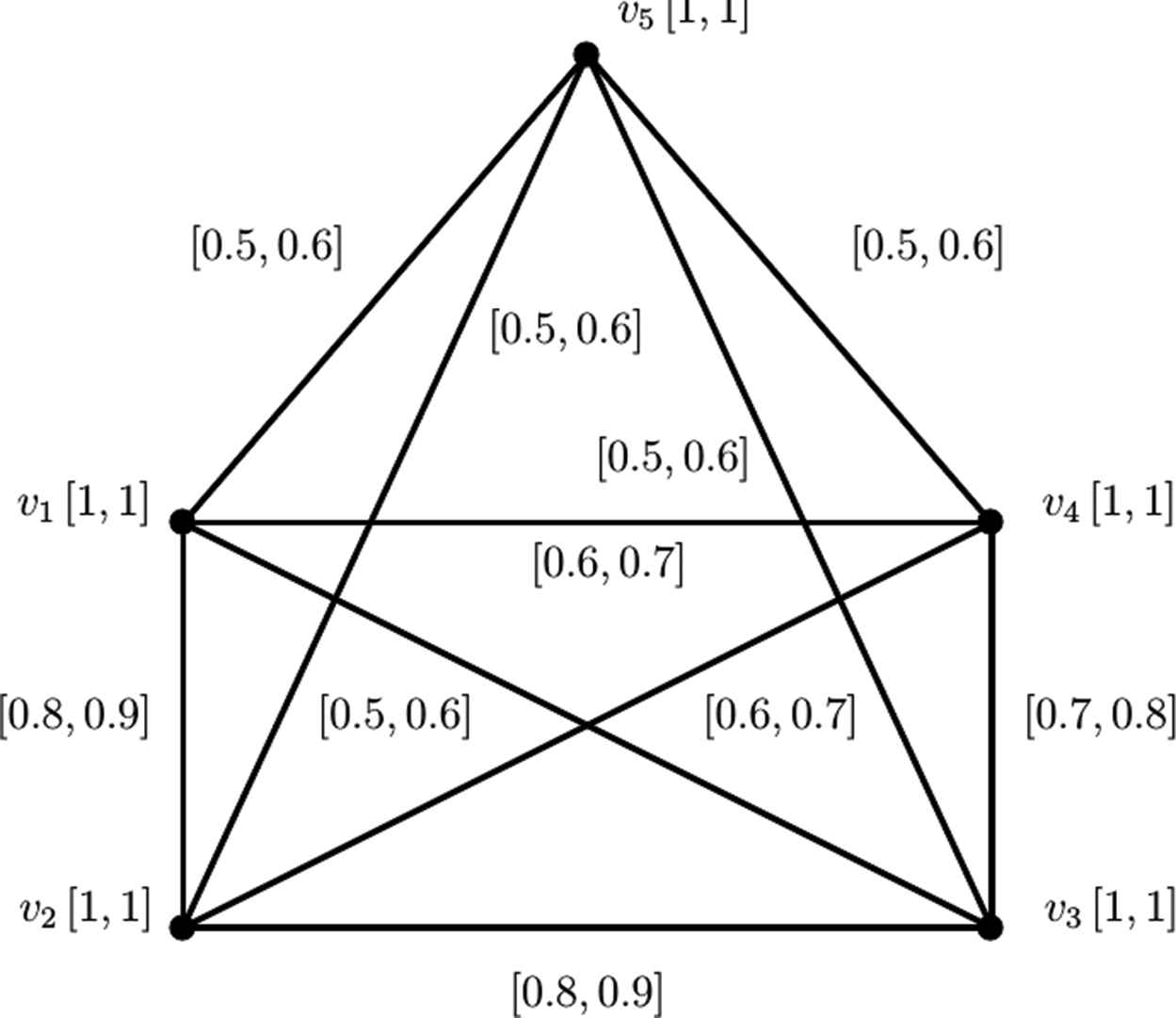

Now, definition of IVFQ should be so modified that the IVFSG induced by each fuzzy clique is complete. This complete IVFQ is known as complete IVFQ.
Definition 4.
(Complete IVFQ) In an IVFG
Now, we see an example of a complete IVFQ as a subgraph of the graph shown in Figure 2.
Example 2.
Consider an IVFSG of the graph in Example 1 induced by
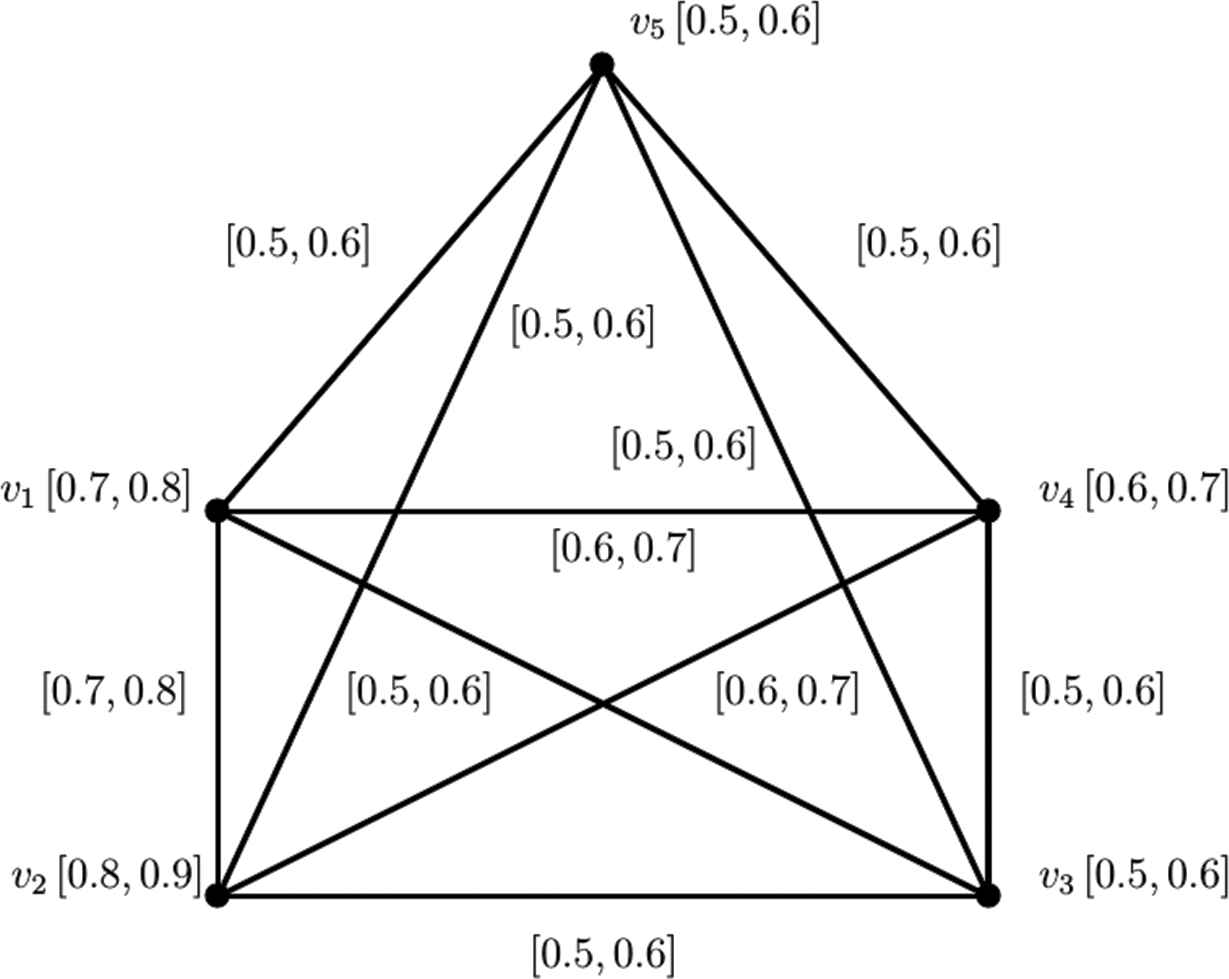
An example of a complete interval-valued fuzzy cliques (IVFQ) of the graph of Figure 2.
Theorem 1.
Each complete IVFSG is an IVFQ.
Proof.
Let
Now, without any loss of generality, suppose that
Then from (1), (3) we have,
Corollary 1.
The IVFSG induced by a complete IVFQ is an IVFQ.
Proof.
By the definition of complete IVFQ we have the IVFSG induced by a complete IVFQ is complete. Then by Theorem 1, it is an IVFQ.
Theorem 2.
If IVFQ is a perfect interval-valued fuzzy strong then it is complete.
Proof.
Let
Theorem 3.
In an IVFG
Proof.
First consider that
Conversely, consider that
The following corollaries are two consequences of Theorem 3.
Corollary 2.
Proof.
Since,
Corollary 3.
Let
Proof.
This is immediate from Theorem 3 since,
In the following, we shall give another characterization of a complete IVFQ. For an IVFG
For a subset
Let
Theorem 4.
If
Proof.
Let
Conversely, let
The following example illustrates Theorem 4.
Example 3.
Let us consider the IVFG
This shows that
Corollary 3 states that every nonempty subset of a complete IVFQ is complete IVFQ. This gives a clue of having maximal and maximum complete IVFQ. Now, we give the definitions of maximal and maximum complete IVFQ.
Definition 5.
(Maximal and maximum complete IVFQ) A complete IVFQ
Using Theorem 4, we can characterize the maximal complete IVFQs.
Theorem 5.
In an IVFG
Proof.
By Theorem 4,
Theorem 6.
Let
Proof.
Let us consider that the set
Corollary 4.
Let
Proof.
Since,
Theorem 7.
Let
Proof.
Let
Case-I. In this case, let us consider,
Case-II. Let us consider
Then
Therefore, considering the Cases I and II, it can be concluded that there is at least one
3. IVFQCs IN IVFGs
In this section, complete IVFQCs and minimum complete IVFQCs are discussed, and an algorithm to find a minimum complete IVFQC of a given IVFG is provided.
Definition 6.
(Complete IVFQ edge cover) A complete IVFQ edge cover for an IVFG
In crisp graphs, if all the edges of the crisp graph
Example 4.
Consider an IVFG
An interval-valued fuzzy graph (IVFG) 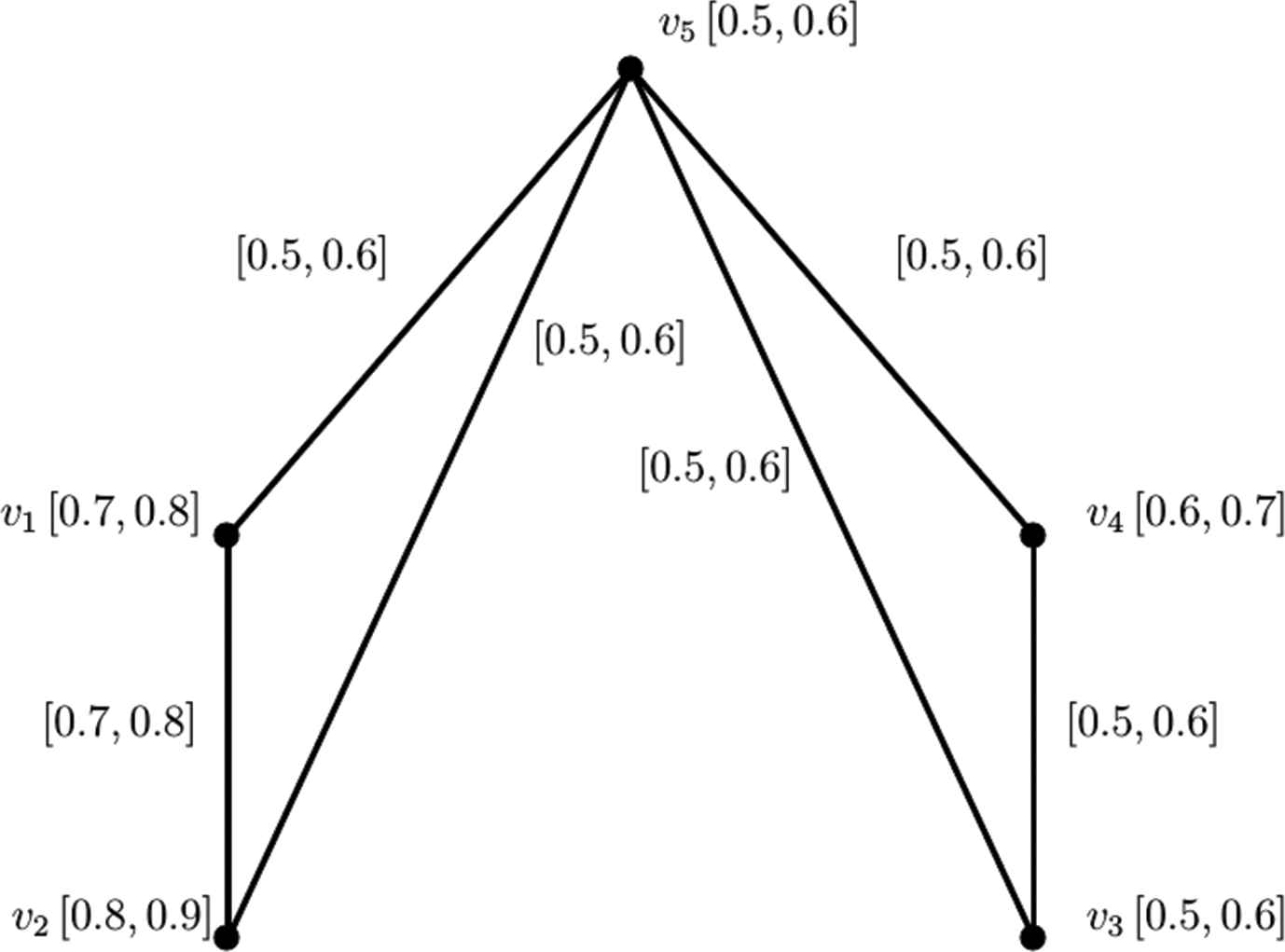
Now,
Example of complete interval-valued fuzzy clique (IVFQ) edge cover of 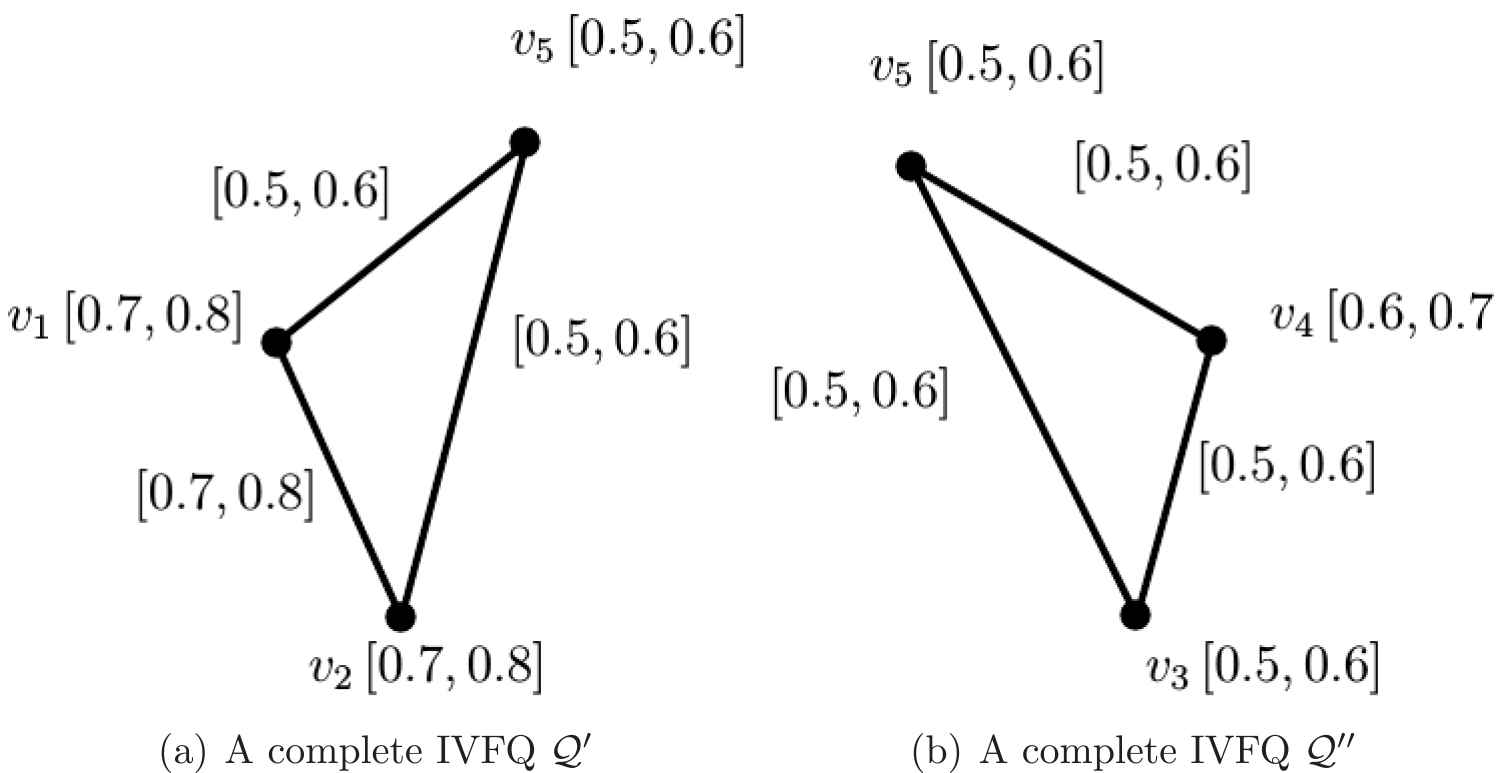
Motivating from this criticism, we define the IVFQC for an IVFG which covers all of the interval-valued fuzzy edges and interval-valued fuzzy vertices.
Definition 7.
(IVFQC) An IVFQC for an IVFG
Before going to characterize the minimum IVFQC, we first give the following lemma.
Lemma 8.
For a complete IVFQ
Proof.
Let
Theorem 9.
For an IVFG
Proof.
For an IVFQC
Theorem 10.
For an IVFG
Proof.
From the definition of
Theorem 11.
For an IVFG
Proof.
It follows from Theorems 9 and 10.
4. APPLICATION OF IVFQC IN MOBILE NETWORKING COMMUNICATION
Today's world advances with wireless technology as much as possible. One of the great uses of wireless technology is in mobile networking. In mobile networking, the communications are done through some cell towers which receives the signals from the base station and send the signals to the mobile devices. These cell towers have some specific range within which it can serve better to reach the signals to the right receiver. Now, the wireless communication companies wants to set up minimum number of cell towers with maximum strength to cover all the region of consideration. This problem can be solved by setting up a model for IVFG where, each cell towers are taken as vertices and with the strength as the fuzzy values and edges are the connection between them and assigning the fuzzy values are their connection strength.
Suppose there are six cell towers with their strength and connections are given as shown in Figure 7. Obvioulsy, this is an IVFG. Now, to cover all the receiving devices by minimum number of cell towers is same as minimizing the number of cell towers which can cover all the towers and the connections between them. And this is equivalently, finding the minimum IVFQC of the IVFG. It is easy to find that, the minimum IVFQC the graph shown in Figure is
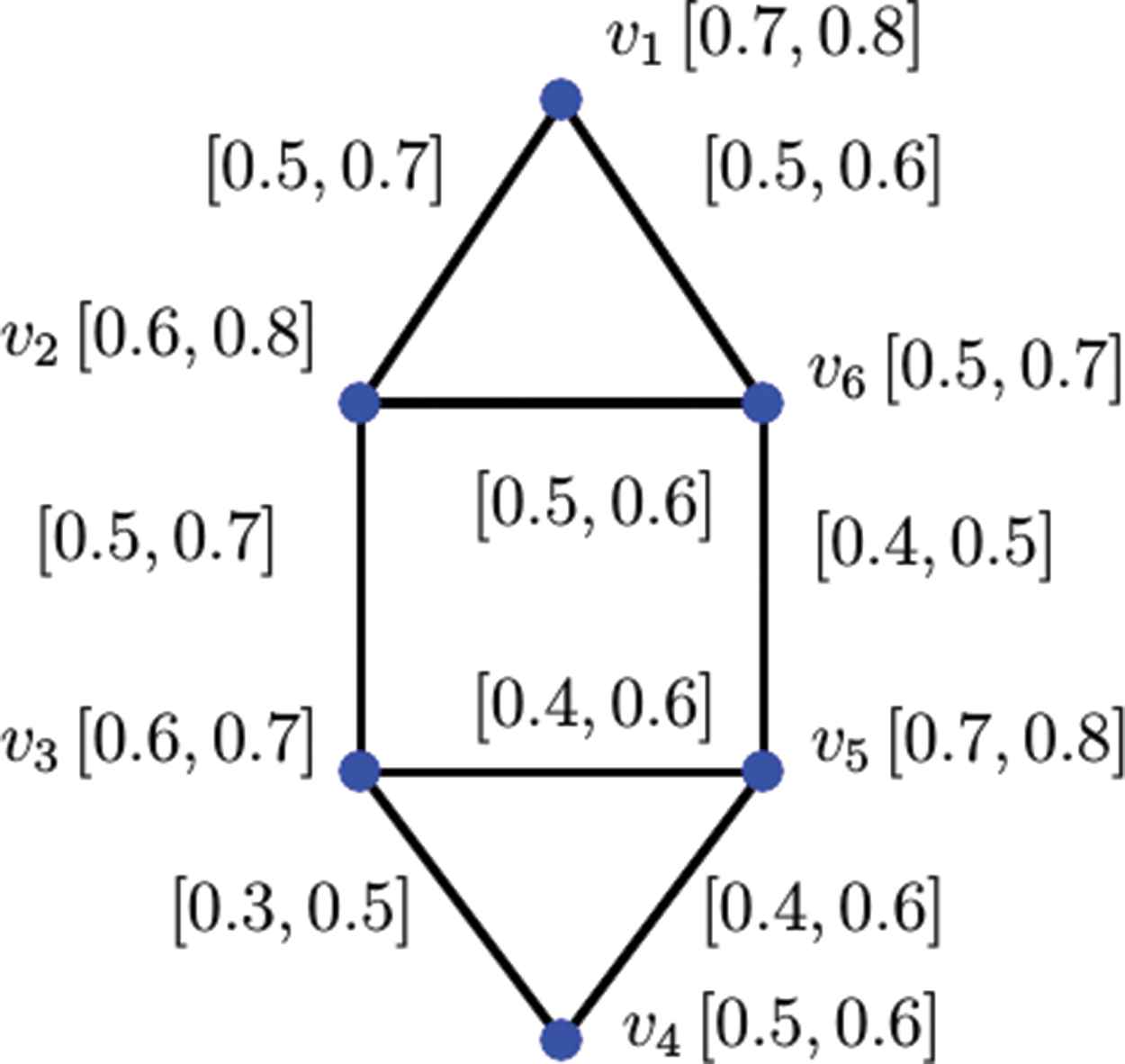
An interval-valued fuzzy graph (IVFG) model of a mobile communication.
5. CONCLUSION
Fuzzy cliques are the most important mathematical model to describe and analyze the relationship networks where one has to deal with the inter-relationships among some objects, like—human, stars, countries, etc. IFVQs are better capable over fuzzy cliques to deal such problems. The definition of IVFQ given by Nair and Cheng does not confront with the classical graph theory in the sense that “each subgraph induces by a clique is complete.” For this reason, we have modified the definition of IVFQ so that each IVFSG induces by an IVFQ is complete. Since, the communication is an important criterion for modern civilization, the study of IVFQs and IVFQCs is more demanding among researchers. The theorems developed in this paper can be applied in several network models such as—setting up wireless cell towers considering several parameters, installation of satellites, development of data searching algorithm, development of social networking sites, etc. Farther studies of this concept can be developed in future so that the theory can also be applied in the real-world situation where the parameters related to objects are self-contradictory or has negative implications.
CONFLICTS OF INTEREST
The authors declare that they have no conflicts of interest.
AUTHORS’ CONTRIBUTIONS
All authors are equally contributed in the paper.
ACKNOWLEDGMENT
Financial support of last author offered by DHESTBT (Govt. of West Bengal, India) (Ref. No. 245(Sanc.)/ST/P/S&T/16G-20/2017) is thankfully acknowledged.
The authors are grateful to the anonymous reviewers for their valuable suggestions.
REFERENCES
Cite this article
TY - JOUR AU - Napur Patra AU - Tarasankar Pramanik AU - Madhumangal Pal AU - Sukumar Mondal PY - 2021 DA - 2021/06/19 TI - Cliques and Clique Covers in Interval-Valued Fuzzy Graphs JO - International Journal of Computational Intelligence Systems SP - 1773 EP - 1783 VL - 14 IS - 1 SN - 1875-6883 UR - https://doi.org/10.2991/ijcis.d.210610.001 DO - 10.2991/ijcis.d.210610.001 ID - Patra2021 ER -
